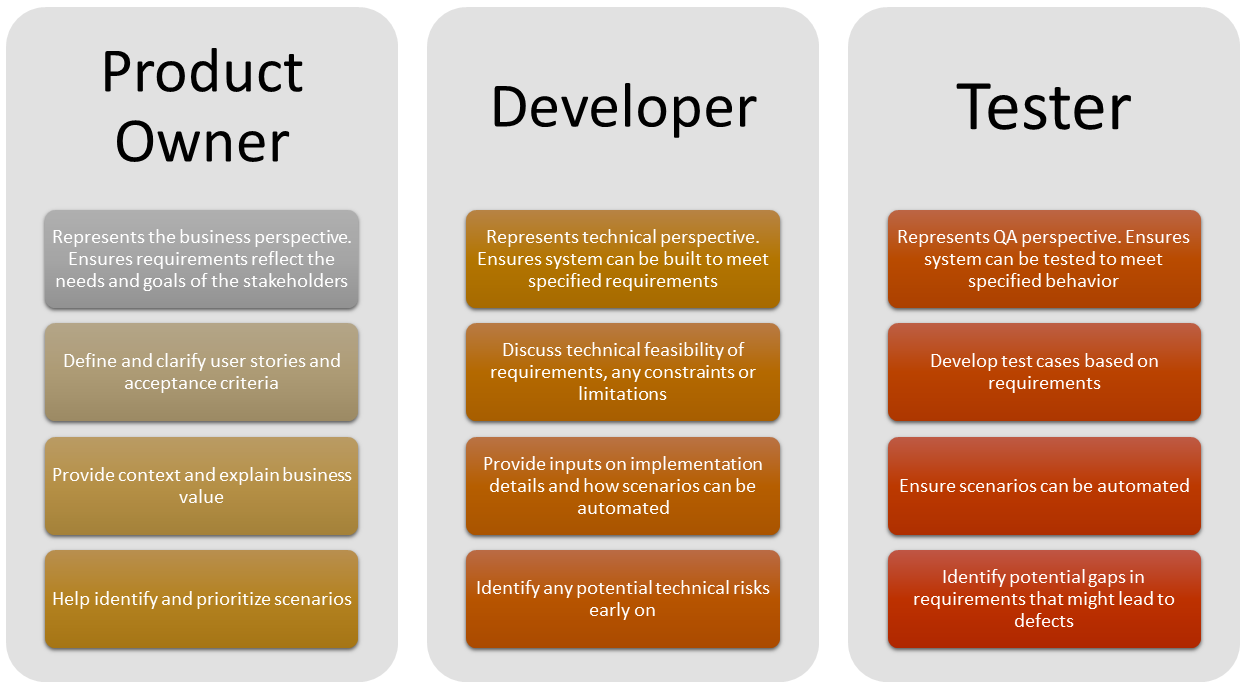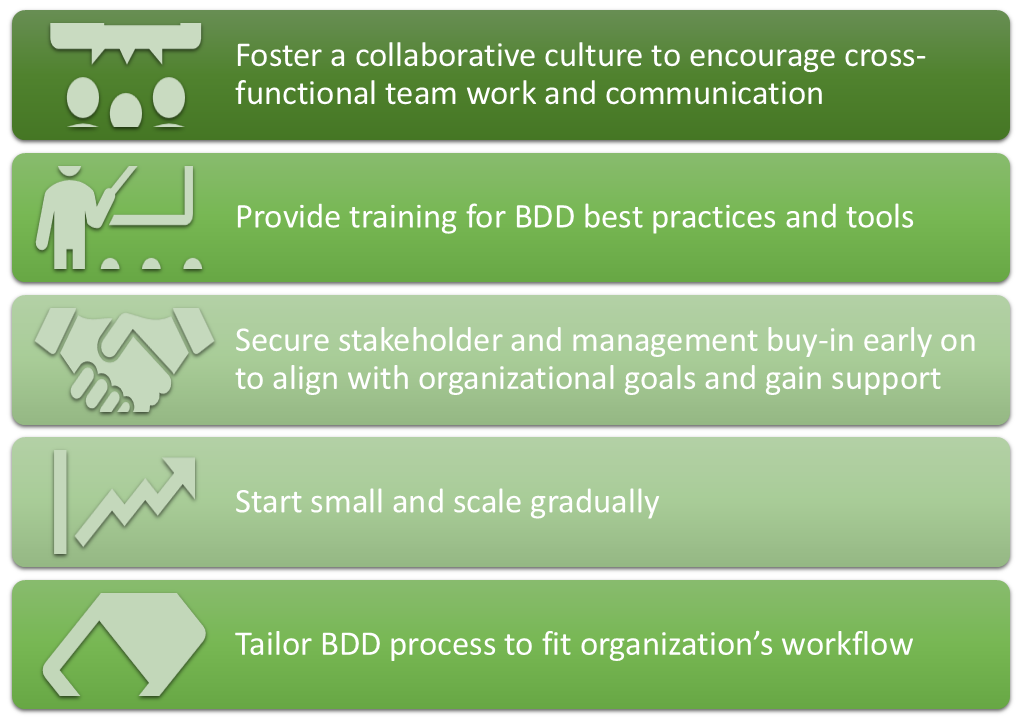What is Behavior Driven Development (BDD)? Everything You Should Know
|
|
Imagine a scenario where a development team spends months building a feature, only to realize it doesn’t quite meet the business’s needs. Or perhaps a seemingly simple user story leads to a complex implementation that fails to deliver the desired outcome.
Behavior-Driven Development (BDD) is a powerful approach that addresses these challenges by focusing on the behavior of a system from a user’s perspective.
Here’s an in-depth view of this popular methodology.
What is Behavior Driven Development (BDD)?
BDD is an approach that focuses on how users will be interacting with the application. Based on this, the application is designed, developed and tested. It helps to have the perspectives of both technical and non-technical stakeholders to develop test cases that assure a high-quality application. Since focus is on the business requirement, examples are used to illustrate the different behaviors of the application.
This approach builds over the TDD and acceptance testing approaches. The Gherkin language is usually what comes to mind when talking about BDD where the scenarios are documented in the Given-When-Then format. This is a popular way of writing BDD test scenarios for user stories. However, it is important to note that BDD is primarily a thought process, rather than a programming language or a tool.
How did BDD come into being?
The history of BDD is intertwined with the evolution of Agile practices and Test-Driven Development (TDD). It has emerged as a natural progression to address challenges and limitations found in earlier development methodologies.
Here’s a quick rundown.
- Agile provided the groundwork for practices that would soon evolve into TDD and BDD.
- Next came TDD. It became a popular Agile practice due to Kent Beck, who introduced it as part of Extreme Programming (XP). TDD aimed to improve code quality by writing tests before code to ensure that each piece of functionality was tested individually. However, TDD focused on technical, low-level tests that were not always accessible or understandable for non-technical stakeholders.
- TDD gave way to BDD, which shifted the focus from testing code to describing desired behavior. This was a subtle but significant change – rather than focusing on “tests” (which could imply a purely technical exercise), BDD introduced the idea of “behaviors” to describe how software should function.
- BDD emphasized the importance of a “ubiquitous language” to describe behaviors in a way that both developers and non-technical stakeholders could understand. This language became known as the Given-When-Then syntax, inspired by the structured format used in requirement gathering but simplified for broader comprehension.
What does BDD entail for the team?
Theoretically, we saw what BDD was meant to do. Now, let’s look at the implementation.

The Three Amigos
BDD terms the product owner, developer, and tester as the three amigos that need to keep communicating at all times to ensure that the customer’s expectations are honored. Each has a different perspective to bring to the table.
- Product owners lend the perspective of the functionality of the product as well as how the system should behave.
- Developers know the technical feasibility of the proposed solution and can suggest viable workarounds or solutions to problems.
- Finally, testers can help with the quality aspect by enlisting corner cases and other scenarios that might occur in real-time.
The Actual Process
The process starts with the three discussing the requirements and trying to assess the technical feasibility and functional validity while ensuring that the quality standards are maintained. Through these discussions, the team attempts to finalize the system behavior, all this considering the customer’s perspective. This acts as the acceptance criteria.
As this approach is built over the TDD approach, it involves writing test cases before the application development is over. During the entire process, a constant communication channel is maintained between the three amigos to ensure that they are on the same page as the customer. If need be, the product owner involves the customer for clarifications.
Now, all the identified test cases are written in a language that all stakeholders understand. A very common example of this is the Gherkin language which focuses on writing the scenario in the Given-When-Then format. Many tools are available today in the market that help with this scenario documentation.
These scenarios are used as guidance by developers to develop the product features and by testers to create test cases. Expectation is that both are ready with their output at the same time so that the developed product can be tested using the test cases created by the testers. In the case that there is an issue with the above testing, required changes are made to the code.
Advantages of BDD
The key advantages of following BDD are:
- Since the scenarios are documented in a language that is understood by both technical and non-technical stakeholders, the communication between them is better.
- All stakeholders are involved early on in the process. This ensures that varied perspectives help finalize an affordable approach that is the most suitable to the business requirements.
- Suitable for teams that operate in agile environments and have continuous integration and continuous development.
- Due to the early alignment of the product’s design and approach, a lot of redundant coding and confusion can be avoided in the development stage.
- This approach helps maintain the quality of the application along with meeting client expectations.
- The test scenarios that are portrayed in the form of examples are discussed with the client to get feedback. This is a continuous process that helps the development of an application that holds true to the client’s ask.
Why BDD doesn’t work in some organizations?
This title might raise some eyebrows since BDD is a very popular approach in the software industry. It turns out that, in many cases a team thinks they are following the BDD culture. However, in reality they’re just using Gherkin to write their test cases and don’t follow the core BDD concepts.
It’s too common to see a picture when BA (business analysts) gather domain knowledge and train developers while also creating functional documents. Manual QA create test cases, which oftentimes the development manager will forget to review. Then during the sprint QA gets the feature ready to test later than planned, leaving testers with barely enough time to complete testing and sign off. At best, automation for this feature will start during the next sprint. Read about Test Automation Tool For Manual Testers.
It’s similar to how many companies nowadays say they’re using Agile. When digging into the core of why Agile doesn’t quite work for them – it turns out they’re still measuring work in human-hours and setting hard deadlines.
Similar to Agile, with BDD it’s crucial to follow the whole process religiously, and don’t forget the core ideas that we’ve talked about in the previous sections. Otherwise, you might be disappointed with the results.
Here are some tips on successfully adopting BDD.

Read more about how BDD can transform organizations in this post – BDD Case Study: Its Benefits and the Way Ahead
Automation testing and BDD
So far we have seen that BDD involves documenting test scenarios in a human-readable format. This saves time in getting alignment among stakeholders. There are tools in the market that help automate BDD cases.
At best (not involving the scenario we’ve talked about above), traditional BDD is a 3-step process:
- Business writes test cases in Gherkin language
- Developers code the feature
- QA engineers automate the Gherkin test cases
testRigor makes following the BDD process an order of magnitude easier by reducing the number of steps. Now, you just need to do the following:
- Business writes test cases in plain English
- Developers code the feature.
Once the feature is ready, simply run the test cases you’ve written in step 1 without any additional modifications. Since testRigor does not rely on details of implementation, you do not need to use Xpaths, CSS Selectors, and so on. “Add to cart” button is just that, nothing else.
Additionally, the tools need to be common and easy to onboard so that both technical and non-technical stakeholders can view the test cases and make changes if needed. With testRigor being a cloud-based application, a simple login on the website is needed to access the necessary test cases.
Apart from this, you can write test cases across different platforms like the web, mobile (hybrid, native), API, desktop apps, and browsers using the same tool in plain English statements. The test maintenance that tends to arise with using BDD is slashed down to a bare minimum here, again thanks to testRigor’s use of AI.
Conclusion
BDD is more than just the Given-When-Then way of documenting requirements – it is a culture that promotes collaboration. The approach facilitates the discussion and brainstorming of the requirement amongst stakeholders prior to putting it into the development cycle. It is best suited for Agile environments as this approach gives developers, product owners, and testers a say throughout the process. The beauty of this process is that different aspects of it can be automated, which makes it very efficient. With various tools like testRigor available in the market, it is also possible to translate most BDD cases into automation test cases.
| Achieve More Than 90% Test Automation | |
| Step by Step Walkthroughs and Help | |
| 14 Day Free Trial, Cancel Anytime |












